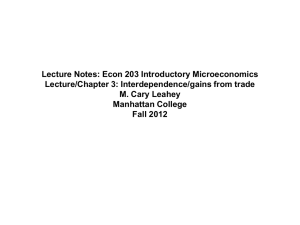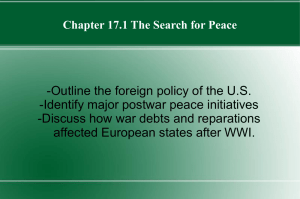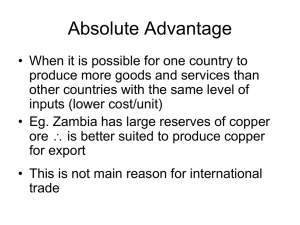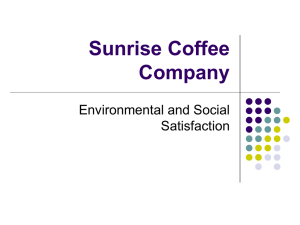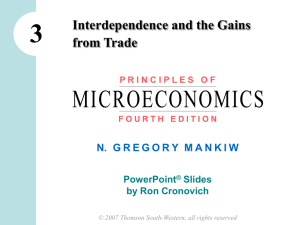Chapter 18 Powerpoint
advertisement
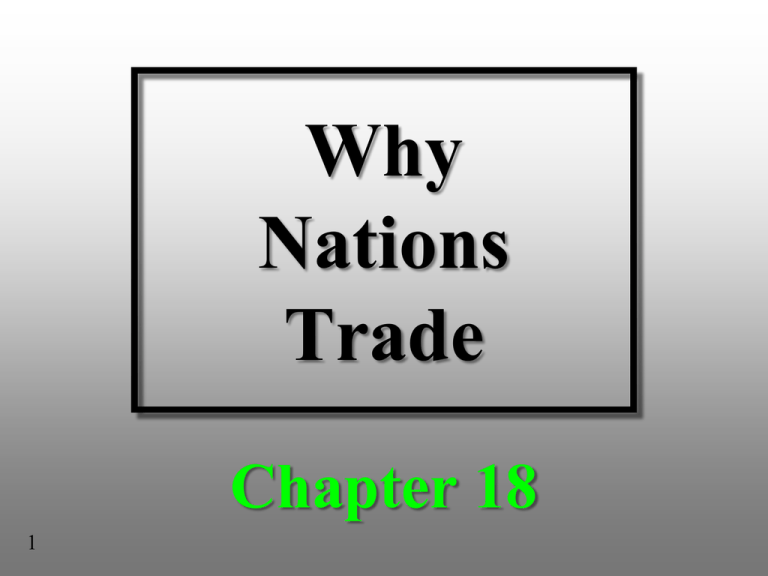
Why Nations Trade Chapter 18 1 Discussion Topics Why trade? Absolute advantage Gains from trade 2 Concepts Affecting Trade Absolute advantage – exists when one nation can produce goods more cheaply than another nation Comparative advantage – ability of a nation to specialize in the production of the good for which it has lowest opportunity cost Competitive advantage – economic 3 competitiveness of a nation reflected in the absolute cost of a given good in a given market at a particular point in time Pages 359-363 Comparative Advantage Comparative advantage : If one nation is less efficient in the production of a good than another nation, there is still a basis of gains from trade A nation should specialize in production and export the good for which its relative (comparative) advantage is greatest A nation should specialize in production and export the good for which it has the least relative disadvantage A nation should import the good for which its relative (comparative) advantage is the least A nation should import the good for which it has the greatest relative disadvantage 4 Pages 359-363 Ratio 5.00 0.67 U.S. is most efficient producer of wheat while Mexico is most efficient producer of coffee With trade 5 U.S. specializes in wheat exchange part of its surplus for coffee Mexico specialize in coffee trade part of the surplus for wheat Page 360 Ratio 5.00 1.33 Mexico→ absolute disadvantage in producing both goods U.S.→ relative advantage greatest in wheat (10/2 vs. 4/3) 6 → U.S. has a comparative advantage in wheat →Mexico has the least comparative disadvantage in coffee or comparative advantage in coffee Page 361 Factors Affecting Comparative Advantage…. National differences in opportunity costs Costs affected by availability of resources Costs affected by production requirements for goods and services produced Costs affected by resource combinations Costs affected by resource mobility 7 Page 362 We assume both countries fully employ all resources, technology and specific amounts of labor per year 8 Page 364 U.S./Mexico Production Possibilities U.S produces 100 tons of wheat and 40 tons of coffee. 200 Mexico produces 32 tons of wheat and 12 tons of coffee U.S. (tons/year) 175 150 125 40 Mexico (tons/year) 32 24 100 16 75 50 25 0 9 8 20 40 60 80 0 12 24 36 48 60 Page 365 U.S./Mexico Production Possibilities B U.S. (tons/year) 175 150 125 C 100 Mexico (tons/year) 32 A 75 50 25 0 40 Wheat Wheat 200 24 16 8 20 40 60 80 0 Coffee Through trade 12 24 36 48 60 Coffee U.S. specializes in wheat (pt B) Trades 50 tons of wheat to Mexico for 45 tons of coffee Consumes more of both goods at pt C (45 tons of coffee and 150 tons of wheat) than at pt A. Comparing C w/ A → U.S. better of with trade 10 Page 365 U.S. (tons/year) B 175 150 125 C 100 A* 32 A 75 50 25 0 Mexico (tons/year) 40 Wheat Wheat 200 C* 50 24 16 8 B* 20 40 Coffee Through trade 60 80 0 12 24 36 48 60 Coffee Mexico specializes in coffee, 60 tons, pt. B* and no wheat Would trade 45 tons of coffee for 50 tons of wheat Consume more of both goods (50 tons of wheat and 15 tons of coffee, pt C*) than at pt A* 11 Comparing C* w/ A* → Mexico better off with trade Summary The law of comparative advantage was contrasted with absolute advantage and competitive advantage. Trade occurs because traders anticipate gains from trading. Comparative advantage determines why nations trade. The basis for trade is differing opportunity costs among nations. Nations specialize in producing those goods in which they are most efficient and exchange these goods with other nations. 12
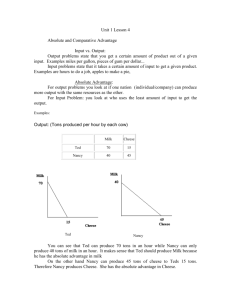
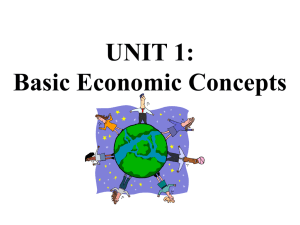
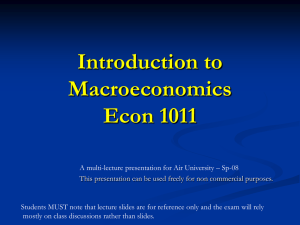
![저기요[jeo-gi-yo] - WordPress.com](http://s2.studylib.net/store/data/005572742_1-676dcc06fe6d6aaa8f3ba5da35df9fe7-300x300.png)

